比例施肥泵吸肥活塞结构优化与试验
2022-02-15易中懿
汤 攀,任 妮,易中懿,李 红
比例施肥泵吸肥活塞结构优化与试验
汤 攀1,任 妮2,易中懿2,李 红1
(1. 江苏大学流体机械工程技术研究中心,镇江 212013;2. 江苏省农业科学院信息中心,南京 210014)
为了提高比例施肥泵的注肥精度,该研究分析了吸液活塞的工作原理,采用二次回归正交组合试验对关键结构参数进行优化,以吸液活塞下端直径、泄流槽宽度以及泄流槽深度为变量,以注入流量为响应指标,建立多元回归模型,并通过试验进行验证。结果表明:在不同压差和设定肥液注入比例下,比例施肥泵的实际肥液注入比例均低于设定肥液注入比例。压差在0.15 MPa以下时,随着设定肥液注入比例的升高,实际肥液注入比例与设定肥液注入比例的偏差减小,采用较高的设定肥液注入比例有利于提高注肥精度。吸液活塞下端直径、泄流槽宽度、泄流槽深度对注入流量都有显著影响(<0.01)。注入流量随着吸液活塞下端直径和泄流槽深度的增大而先升高后降低,随泄流槽宽度的增大而增大。对注入流量的影响顺序从大到小依次为泄流槽宽度、泄流槽深度、吸液活塞下端直径。优化后的吸液活塞下端直径为16.6 mm、泄流槽宽度为5.5 mm和泄流槽深度为3.7 mm,工作压差为0.05、0.10和0.15 MPa时的注肥精度分别提高了3.33、1.67和7.29个百分点。研究结果可为比例施肥泵的优化设计及实际应用提供理论支持。
肥料;试验;水肥一体化;比例施肥泵;参数优化;回归方程
0 引 言
长期以来,肥料的大量与不合理施用对自然生态环境造成了严重破坏,如土壤肥力破坏、土壤污染、面源污染等,严重影响了农业的可持续发展[1-2]。因此,减少化肥使用量、合理施肥、提高化肥利用率已成为农业可持续发展和保障粮食安全的重要手段[3-5]。水肥一体化是精确施肥与精确灌溉相结合的产物,在灌溉技术中占有重要地位[6-8]。施肥设备是水肥一体化系统的关键,其性能的优劣直接影响灌溉与施肥的质量。比例施肥泵是一种先进的水肥一体化施肥装备,其通过水压驱动内部吸液活塞的运动来向管网中定量添加肥液,与其他施肥设备相比,比例施肥泵的施肥精度高,且肥液注入比例可在一定范围内进行调节[9-10]。
法国Dosatron公司早在1974就开发出了比例施肥泵,此后经过不断发展,目前已开发出了系列产品,可以满足不同应用场合的需求。国内在施肥泵方面的研究较晚,李百军等[11]从原理及试验上初步研制过水动比例施肥泵,但没有形成产品。王建东等[12]制造出施肥泵样品并进行了试验测试,虽然试验结果表明该施肥泵可以基本满足微灌施肥的需要,但与国外产品相比仍有可改进空间。针对水力性能研究,韩启彪等[13]对一些典型产品进行了性能测试,根据试验结果给出了典型产品的工作压差和流量关系以及工作压差的合理控制范围等较重要参数。杨大森等[14-15]对3种比例施肥泵的水力性能进行了试验,提出了比例施肥泵驱动腔和吸肥腔的容积效率计算公式。Tang等[16-17]研究了比例施肥泵注入液体的黏度对进口流量和注入流量的综合影响,并建立了进口流量计算模型和注入流量计算模型。目前已有研究主要侧重于单个运行及结构参数对某一水力性能的简单外特性试验研究,缺乏总体运行与结构参数对综合水力性能及其影响机理的深入研究。随着计算流体动力学(Computational Fluid Dynamics, CFD)的发展,数值模拟已成为目前研究流体机械内部流动规律的主要手段之一。汤攀等[18]在比例施肥泵运行机理分析的基础上,采用流固耦合动网格技术进行数值模拟,分析其内部流动以及活塞受力。此外,王睿等[19]研究了施肥泵施肥比例与肥水比对过滤器堵塞的影响,提出了网式和叠片式过滤器的适宜肥液浓度。吴锡凯[20]指出为了提高施肥精度,在运行时不要使用较大压差与较小施肥比例配合,当肥液注入比例设定在2%~4%时,实际所需的施肥时间与设定时间相比增加了近1/4,这表明实际注入流量要小于理论注入流量,即比例施肥泵的注肥精度仍有待提高。
目前国内比例施肥泵的研发和制造与国外相比尚有较大差距,依然缺乏自主的设计方法和优秀产品。吸肥活塞作为比例施肥泵实现肥液抽吸的关键水力部件,其结构参数对比例施肥泵的注肥精度具有重要影响。基于此,本文通过旋转优化试验设计方法对吸肥活塞的关键结构参数进行研究,建立各参数与性能指标的关系式,分析各因素的影响规律,以期为比例施肥泵的性能研究及关键水力部件优化设计提供参考。
1 吸液活塞工作原理
比例施肥泵的主要结构及工作原理已有详细介绍[15-16],如图1所示,吸液活塞在往复运动过程中首先需要将肥液从外部吸入到吸液活塞腔,然后将其排出到驱动活塞腔与驱动液体混合进而排出泵体。吸液活塞在吸液过程中需保持密封状态,在排液过程中需起到将吸肥腔与驱动腔连通的作用。
如图2所示为吸液活塞二维结构图,活塞头两侧开有泄流槽,由于单独活塞头无法完成密封与连通功能的切换,因此在吸液活塞头中间加入滑动密封圈来控制泄流槽的连通与关闭,其主要结构参数为:吸液活塞下端直径15.5 mm、泄流槽宽度4.5 mm及泄流槽深度3 mm。
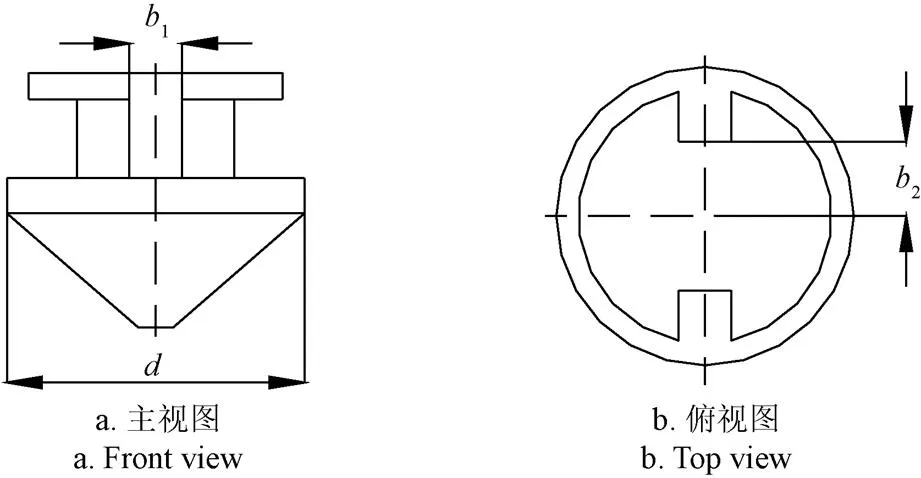
注:d为吸液活塞下端直径,mm;b1为泄流槽宽度,mm;b2为泄流槽深度,mm。
如图3a所示,当吸液活塞向上运动时,由于密封圈与吸液活塞腔壁面存在摩擦,使密封圈与吸液活塞头的下端紧贴,从而阻断泄流槽与吸液活塞腔的连通,使吸液活塞腔在活塞向上运动过程中形成负压将外部液体吸进活塞腔。如图3b所示,当吸液活塞向下运动时,由于密封圈与吸液活塞腔壁面存在摩擦,使密封圈与吸液活塞头的上端紧贴,从而通过泄流槽将吸液活塞腔与驱动活塞腔进行连通。吸液活塞向下运动的同时将活塞腔里面的液体挤压,通过泄流槽排进驱动活塞腔与工作液体混合。

注:箭头表示液体流动方向。
2 试验方案
为了研究比例施肥泵效率和实际注入流量与运行参数之间的关系,搭建了比例施肥泵性能测试试验台,如图4所示,通过调节比例施肥泵前后的阀门来控制其工作压差。试验在江苏大学流体机械工程技术研究中心的室内喷灌试验室进行,采用意大利Dosatron公司的D25RE2比例施肥泵,其进出口直径19 mm,最大承受压力为0.60 MPa,设定肥液注入比例0.2%~2.0%。测试系统主要由水泵、测量装置和控制装置组成。系统管路为钢管,主管路直径50 mm,旁路管直径25 mm。离心泵流量10 m3/h,扬程70 m。主管道流量通过电磁流量计测量,精确度为±0.3%。比例施肥泵吸液速度由精度为0.1 g的精密电子天平测量。在比例施肥泵前后以及主管上安装3个精度为±0.4%的压力表,试验参照国家标准GB/T 19792-2012《农业灌溉装备水动化肥—农药注入泵》[21]进行。
试验主要测试比例施肥泵在不同压差和不同设定肥液注入比例下的注入流量和进口流量。根据比例施肥泵的最大承受压力,试验共设置8个水平的压差,分别为0.05、0.10、0.15、0.20、0.25、0.30、0.35、0.40 MPa,试验过程中将比例施肥泵的进口压力保持在0.60 MPa,然后调节出口压力,使比例施肥泵所设定的不同压差下工作。设定肥液注入比例共设置13个水平,为了更加精确地测量肥液注入比例较小时的水力性能,当设定肥液注入比例在0.8%以下时,间隔为0.1%,当设定肥液注入比例大于0.8%时,间隔为0.2%。比例施肥泵的进口流量直接通过电磁流量计获得,由于注入流量相对进口流量较小,为了提高测试精度,通过如下公式计算:

1.电机 2.水泵 3.压力表1 4.阀门1 5.电磁流量计 6.阀门2 7.压力表2 8.压力表3 9.阀门3 10.比例施肥泵 11.储液罐 12.精密电子天平 13.水池1 14.水池2

式中为注入流量,kg/h;1为储液罐的初始质量,kg;2为测试结束时储液罐的质量,kg;为测试时间,h。在本研究中,每次测试的时间为0.5 h。试验过程中,改变测试工作压差和设定肥液注入比例时,需待比例施肥泵运行稳定后开始测量,每个测试点3次重复,取均值为最终试验结果。
3 结果与分析
表1为比例施肥泵在不同设定肥液注入比例和压差下的注入流量。理论上,随着压差的增大,活塞往复运动频率升高,吸液活塞吸液速度会增加,然而从表1可以看出,随着压差的增大,比例施肥泵在不同设定肥液注入比例下的注入流量都呈现先增大后趋于平稳或减小的趋势,表明压差的增大不能有效增加比例施肥泵的吸液速度,即活塞运动频率过高会降低比例施肥泵的性能,其工作压差应控制在0.20 MPa以内。表2为比例施肥泵在不同设定肥液注入比例和压差下的进口流量,从表2可以看出,比例施肥泵的进口流量随着压差的增大而增大;在同一压差下,随着设定肥液注入比例的升高有较小幅度的降低,可认为设定肥液注入比例对进口流量的影响较小,这与吴锡凯[20]的研究相吻合。

表1 不同设定肥液注入比例和压差下的注入流量
注:s为设定肥液注入比例,%;表中数据为均值±标准差,下同。
Note:sis the set injection ratio, %; data in the table are mean ± standard deviation, the same as below.

表2 不同设定肥液注入比例和压差下的进口流量
实际肥液注入比例为实际注入流量与进口流量的比值,即:
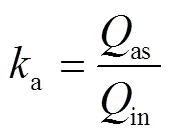
式中a为实际肥液注入比例,%;as为实际注入流量,kg/h;in为进口流量,kg/h。
通过公式(2)计算可得如图5所示的比例施肥泵在不同压差下的实际肥液注入比例和设定肥液注入比例的对比,从图中可以看出,随着压差的增大,实际肥液注入比例与设定肥液注入比例的偏差越大;压差在0.15 MPa以下时,随着设定肥液注入比例的升高,实际肥液注入比例与设定肥液注入比例的偏差越小,表明采用较高的设定肥液注入比例有利于提高比例施肥泵的注入精度。Tang等[18]在研究注入液体黏度对进口流量和注入流量影响时也同样指出比例施肥泵的最大工作压差不应过高。在不同的压差和设定肥液注入比例下,比例施肥泵的实际肥液注入比例都低于设定肥液注入比例,一方面,这是由于比例施肥泵存在一定的容积损失,无法按照设定的肥液注入比例进行抽吸;另一方面,吸液活塞是实现肥液抽吸的关键水力部件,其关键结构参数对比例施肥泵的注入流量具有重要的影响。

图5 不同压差下的实际肥液注入比例和设定肥液注入比例
4 参数优化
根据吸液活塞工作原理可知吸液活塞的结构尺寸对液体流动产生主要影响的有吸液活塞下端直径、泄流槽宽度1以及泄流槽深度2。因此,选取这3个主要参数探索吸肥活塞流道结构尺寸对比例施肥泵施肥精度的影响规律。
比例施肥泵的注入精度是最能体现其水力性能优越的重要指标,当比例施肥泵的注入精度较低,即实际注入流量与理论注入流量差别较大时,会造成施肥时间过长或施药浓度达不到目标设定值,进而影响施肥或施药效果。根据图5,比例施肥泵的实际肥液注入比例都低于设定肥液注入比例,即不同设定肥液注入比例下的实际注入流量都小于理论注入流量。比例施肥泵在同一设定肥液注入比例及压差下工作时,注入流量越大,则注入精度越高,故选择注入流量作为本文的试验指标。根据表1和图5,设定肥液注入比例越低,实际注入流量与理论注入流量的偏差越大,故试验中将比例施肥泵的工作参数定为设定肥液注入比例0.2%,工作压差0.05 MPa,研究吸液活塞流道结构参数对注入精度的影响规律。
4.1 二次回归正交组合试验
试验采用二次回归正交组合设计[22-24],根据前期试验确定比例施肥泵能正常工作时各参数的取值范围为:吸液活塞下端直径(12~18 mm)、泄流槽宽度(4~6 mm)和泄流槽深度(2~4 mm)。由于因素数=3,则二水平试验次数c=23=8,取零水平试验次数0=1,根据二次回归正交试验设计中星号臂长度的计算公式

计算得到=1.215。因素的上下星号臂水平为因素的上下限,零水平为上下限的算术平均值,变化间距Δ的计算公式为

式中x为上星号臂水平,0为零水平。
因素的上下水平计算公式分别为


根据试验设计得到试验因素水平编码表见表3。

表3 试验因素水平编码表
根据因素水平编码表的参数值及表4中的不同参数组合首先在Pro/E中完成三维造型,然后采用快速成型技术(Rapid Prototyping Manufacturing, RPM)加工,材料为ABS树脂,活塞头试件如图6所示。试验测试结果见表4。
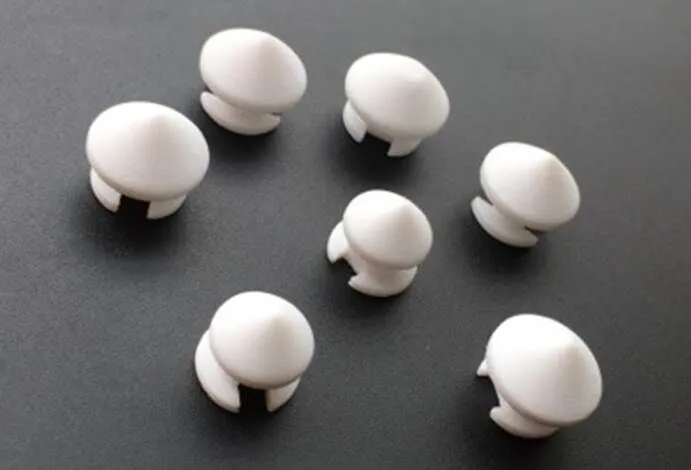
图6 吸液活塞头试件
将试验方案及结果导入Design-Expert 8.0.5.0,对试验数据处理和响应面分析,采用回归分析法建立三元二次回归方程
=0.084 25+0.094 167+0.263 751−0.022 752+
0.008 3331+0.013 3332+0.052 512−
0.005 8062−0.049 7512−0.069 7522(7)

表4 二次回归组合设计试验方案及试验结果
注:为注入流量,kg·h-1。
Note:is injection flowrate, kg·h-1.
对试验结果进行方差分析和显著性检验,如表5所示。从表5中可以看出,注入流量模型的值小于0.01,注入流量回归模型极显著。模型决定系数2=0.957 4,表明模型能够反映出95.74%的响应值变化,失拟项不显著,说明试验误差小,试验各因素对注入流量影响的大小顺序依次为泄流槽宽度、泄流槽深度、吸液活塞下端直径;3个因素的交互作用对注入流量影响的大小顺序依次为,泄流槽宽度×泄流槽深度、吸液活塞下端直径×泄流槽深度、吸液活塞下端直径×泄流槽宽度。显著性分析结果表明所选试验因素都对注入流量有较为显著的影响,且其各因素之间的相互交互作用同样对注入流量具有显著的影响,这表明本文所选择的吸液活塞流道结构参数都为关键水力结构参数。
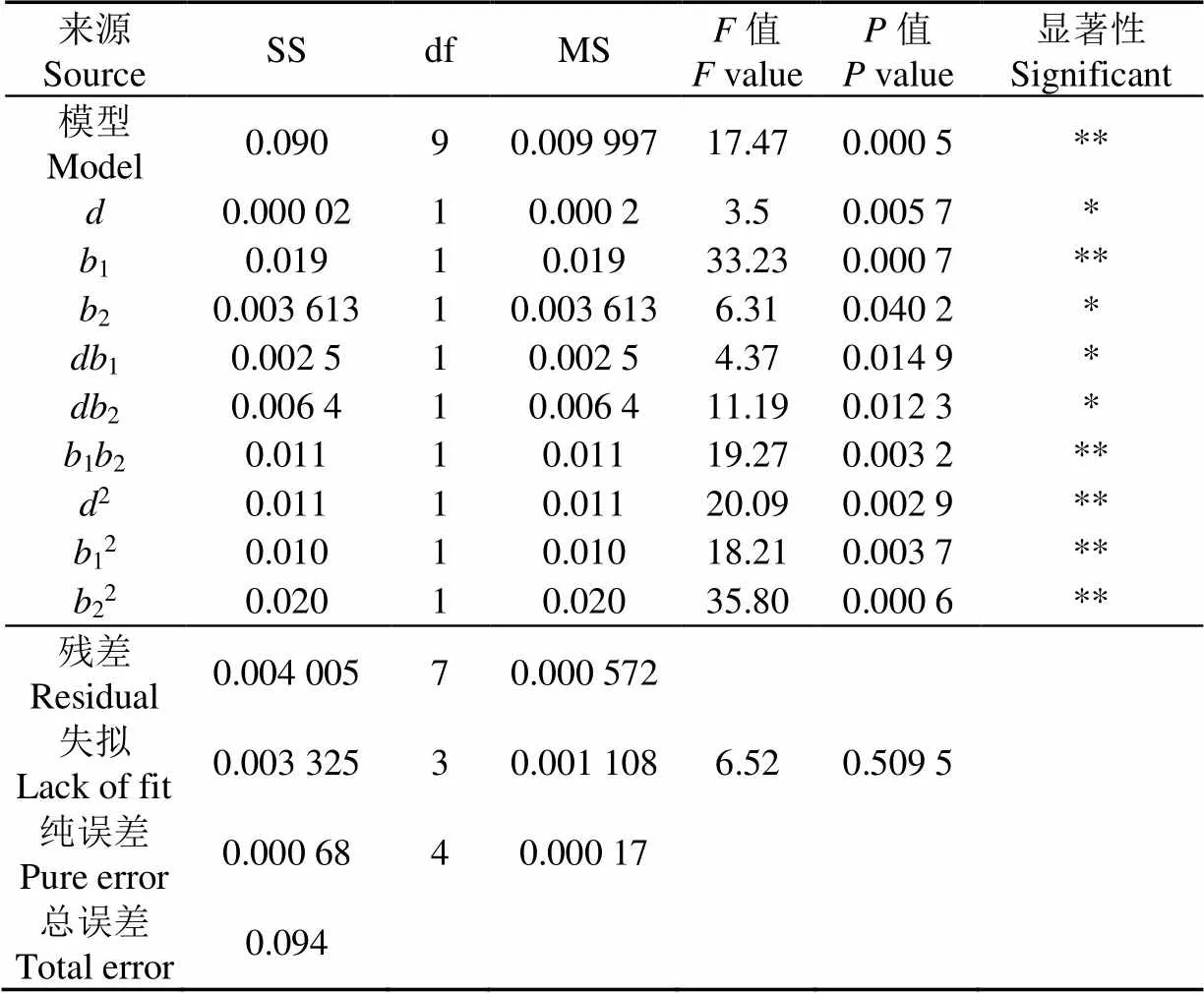
表5 试验指标方差分析表
注:SS为离差平方和;df为自由度;MS为均方;*代表差异显著(<0.05);**代表差异极显著(<0.01)。
Note: SS is sum of squares; df is degree of freedom; MS is mean squares; * is significant (<0.05); ** is very significant (<0.01).
图7为吸液活塞下端直径与泄流槽宽度交互作用对注入流量的影响,从图7可以看出,在同一泄流槽宽度下,注入流量随着吸液活塞下端直径的增大而先升高后降低,表明吸液活塞下端直径在确定范围内存在一个最优值。从吸液活塞结构上分析,吸液活塞下端直径过大或过小都不利于提高比例施肥泵的注入精度,这是由于当吸液活塞下端直径过大时会使吸液活塞与吸液活塞腔的间隙变小,增大被吸液体在排液过程中的阻力,从而使注入流量变小;相反,当吸液活塞下端直径过小时,吸液活塞与吸液活塞腔的间隙变大,造成吸液活塞下端对滑动密封垫圈的支撑变小,导致吸液活塞在向上运动吸取液体时的密封性变差。吸液活塞下端直径小于14 mm时,注入流量同样随着泄流槽宽度的增大而先升高后降低,当吸液活塞下端直径在14~17 mm时,注入流量随着泄流槽宽度的增大而增大。

图7 吸液活塞下端直径与泄流槽宽度交互作用对注入流量的影响
图8为吸液活塞下端直径与泄流槽深度交互作用对注入流量的影响,从图8可以看出,在设定范围内,注入流量随吸液活塞下端直径与泄流槽深度的增大而先升高后降低。泄流槽深度过大或过小都会造成液体流经吸液活塞的流道过大或过小,流道尺寸较大一方面会降低流体从吸液腔到混合器的流动阻力,另一方面又会造成吸液活塞换向运动时(即由排液过程变为吸液过程)残留在泄流槽中的液体增多,从而影响注入流量。

图8 吸液活塞下端直径与泄流槽深度交互作用对注入流量的影响
图9所示为泄流槽宽度与泄流槽深度交互作用对注入流量的影响,从图中可以看出,此交互作用影响与吸液活塞下端直径与泄流槽宽度交互作用对注入流量的影响类似。当泄流槽深度小于2.5 mm时,注入流量随泄流槽宽度的增大基本保持不变,此时泄流槽宽度对注入流量的影响较小;当泄流槽深度大于2.5 mm时,注入流量随泄流槽宽度的增大而升高。

图9 泄流槽宽度与泄流槽深度交互作用对注入流量的影响
4.2 优化求解及试验验证
模型共有3个设计变量,是一个非线性数学规划问题[25-26]。
目标函数如下

根据式(8)目标函数与约束条件进行参数求解,得到如表6所示的吸液活塞流道结构参数优化结果及优化前后的注入流量。从表6中可以看出,吸液活塞流道结构参数优化后的注入流量得到了较大幅度的提高,从优化前的1.26 kg/h提高到了1.61 kg/h,提高幅度为27.78%。

表6 优化前后参数及性能对比
对优化结果进行圆整,取吸液活塞下端直径为16.6 mm、泄流槽宽度为5.5 mm和泄流槽深度为3.7 mm,并进行验证试验,测试优化后比例施肥泵分别在压差为0.05、0.10和0.15 MPa时不同设定肥液注入比例下的注入流量,并与原型比例施肥泵注入流量进行对比,结果如表7所示。从表7中可以发现,优化后的注入流量在不同设定肥液注入比例和工作压差下都较原型比例施肥泵有一定提高。特别是当设定肥液注入比例较低时,优化后的实际注入流量更接近理论注入流量(进口流量与设定肥液注入比例的乘积),同时实际注入流量与理论注入流量的偏差进一步降低,在一定程度上提高了比例施肥泵的注入精度,从而有效提高了比例施肥泵的水力性能。当工作压差为0.15 MPa时,优化后的注入流量较优化之前有一定的提高,且在较高设定肥液注入比例下的实际注入流量与理论注入流量的差距进一步缩小(压差为0.15 MPa和肥液注入比例为2.0%时的偏差从优化之前的9.31%降低到优化之后的4.24%),从而提高了比例施肥泵的正常工作压差范围,有利于比例施肥泵的实际应用,因为高精度的注肥比例可以有效降低水肥一体化系统肥液浓度的变化,从而提高施肥均匀性[27-29]。

表7 不同压差下比例施肥泵吸液活塞流道优化前后的注入流量
注:T.V为理论值;M.V为原型值;D.V1为原型值与理论值的偏差;O.V为优化值;D.V2为优化值与理论值的偏差。
Note: T.V is the theoretical value; M.V is the prototype value; D.V1is the deviation between the prototype value and the theoretical value; O.V is the optimal value; D.V2is the deviation between the optimal value and the theoretical value.
为进一步分析吸肥活塞优化前后比例施肥泵整体注肥精度的变化,将不同压差下吸肥活塞流道结构参数优化前后比例施肥泵的实际肥液注入比例与对应的设定肥液注入比例进行对比,同时定义同一压差下实际肥液注入比例与理论肥液注入比例比值的算术平均值为注肥精度,表示为
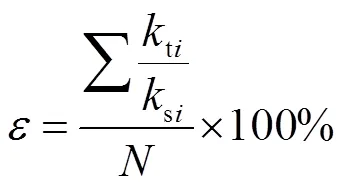
式中为注肥精度,%;ti为比例施肥泵实际肥液注入比例,%;si为对应的设定肥液注入比例,%;为同一压差下的样本数量;为同一压差下的样本编号,1≤≤。通过计算得到如表8所示的对比结果,从表8中可以发现,优化后的实际肥液注入比例与设定肥液注入比例更接近,二者的偏差比优化前的小。比例施肥泵在工作压差为0.05、0.10和0.15 MPa时的注肥精度分别从82.74%、84.76%和65.29%提高到了86.07%、86.43%和72.58%,分别提高了3.33、1.67和7.29个百分点。

表8 不同压差下比例施肥泵吸液活塞流道优化前后的注肥精度
注:tm为原型比例施肥泵实际肥液注入比例,%;to为吸液活塞流道结构参数优化后比例施肥泵实际肥液注入比例,%;为注肥精度,%。
Note:tmis the actual fertilizer injection rate of the prototype proportional fertilization pump, %;tois the actual fertilizer injection rate of the proportional fertilization pump after the structural parameters of the suction piston were optimized, %;is the fertilizer injection accuracy, %.
5 结 论
本研究通过二次回归正交组合试验设计对比例施肥泵吸液活塞关键结构参数进行了优化研究,得到的主要结论如下:
1)在不同压差和设定肥液注入比例下,比例施肥泵的实际肥液注入比例都低于设定肥液注入比例。压差在0.15 MPa以下时,随着设定肥液注入比例的升高,实际肥液注入比例与设定肥液注入比例的偏差越小,采用较高的设定肥液注入比例有利于提高注肥精度。
2)吸液活塞下端直径、泄流槽宽度以及泄流槽深度都对注入流量有较为显著的影响(<0.01);各因素在选取的水平范围内对注入流量的影响大小顺序依次为泄流槽宽度、泄流槽深度、吸液活塞下端直径。
3)在同一泄流槽宽度下,注入流量随着吸液活塞下端直径的增大而先升高后降低。当吸液活塞下端直径小于14 mm时,注入流量随着泄流槽宽度的增大而先升高后降低,当吸液活塞下端直径在14~17 mm时,注入流量随着泄流槽宽度的增大而增大。注入流量随着吸液活塞下端直径与泄流槽深度的增大而先升高后降低。当泄流槽深度小于2.5 mm时,注入流量随泄流槽宽度的增大基本保持不变;当泄流槽深度大于2.5 mm时,注入流量随泄流槽宽度的增大而升高。
4)优化后的吸液活塞下端直径为16.6 mm、泄流槽宽度为5.5 mm、泄流槽深度为3.7 mm。比例施肥泵在工作压差为0.05、0.10和0.15 MPa时的注肥精度较优化前分别提高了3.33、1.67和7.29个百分点。
[1] 刘钦普,孙景荣,濮励杰. 中国及欧美主要国家化肥施用强度与综合效率比较研究[J]. 农业工程学报,2020,36(14):9-16.
Liu Qinpu, Sun Jingrong, Pu Lijie. Comparative study on fertilization intensity and integrated efficiency in China and Euro-American major countries[J]. Transactions of the Chinese Society of Agricultural Engineering (Transactions of the CSAE), 2020, 36(14): 9-16. (in Chinese with English abstract)
[2] 王晶晶,卓越,张颢晖,等. 柱塞式注肥泵的设计试验及精准施肥应用[J]. 排灌机械工程学报,2022,40(1):22-29.
Wang Jingjing, Zhuo Yue, Zhang Haohui, et al. Design and test of piston injection pump and its application in precise fertigation[J]. Journal of Drainage and Irrigation Machinery Engineering, 2022, 40(1): 22-29. (in Chinese with English abstract)
[3] Chiaregato C G, Souza C F, Faez R. The fertilizer release into water and soil as the biodegradation process in the sustainable material enhancing the fertilizer efficiency[J]. Environmental Technology & Innovation, 2021, 22: 101417.
[4] Xu M, Liu M J, Liu F, et al. A safe, high fertilizer-efficiency and economical approach based on a low-volume spraying UAV loaded with chelated-zinc fertilizer to produce zinc-biofortified rice grains[J]. Journal of Cleaner Production, 2021, 323: 129188.
[5] Zhang M, Yao Y L, Tian Y H, et al. Increasing yield and N use efficiency with organic fertilizer in Chinese intensive rice cropping systems[J]. Field Crops Research, 2018, 227: 102-109.
[6] 刘俊萍,朱兴业,袁寿其,等. 中国农业节水喷微灌装备研究进展及发展趋势[J]. 排灌机械工程学报,2022,40(1):87-96.
Liu Junping, Zhu Xingye, Yuan Shouqi, et al. Research and development trend of agricultural water-saving sprinkler and micro-irrigation equipment in China[J]. Journal of Drainage and Irrigation Machinery Engineering, 2022, 40(1): 87-96. (in Chinese with English abstract)
[7] 朱德兰,阮汉铖,吴普特,等. 水肥一体机肥液电导率远程模糊PID控制策略[J]. 农业机械学报,2022,53(1): 186-191.
Zhu Delan, Ruan Hancheng, Wu Pute, et al. Strategy on remote fuzzy PID control for fertilizer liquid conductivity of water fertilizer integrated machine[J]. Transactions of the Chinese Society for Agricultural Machinery, 2022, 53(1): 186-191. (in Chinese with English abstract)
[8] 王振华,陈潇洁,吕德生,等. 水肥耦合对加气滴灌加工番茄产量及品质的影响[J]. 农业工程学报,2020,36(19):66-75.
Wang Zhenhua, Chen Xiaojie, Lyu Desheng, et al. Effects of water and fertilizer coupling on the yield and quality of processing tomato under aerated drip irrigation[J]. Transactions of the Chinese Society of Agricultural Engineering (Transactions of the CSAE), 2020, 36(19): 66-75. (in Chinese with English abstract)
[9] 李红,汤攀,陈超,等. 中国水肥一体化施肥设备研究现状与发展趋势[J]. 排灌机械工程学报,2021,39(2):200-209.
Li Hong, Tang Pan, Chen Chao, et al. Research status and development trend of fertilization equipment used in fertigation in China[J]. Journal of Drainage and Irrigation Machinery Engineering, 2021, 39(2): 200-209. (in Chinese with English abstract)
[10] Tang P, Li H, Issaka Z, et al. Effect of manifold layout and fertilizer solution concentration on fertilization and flushing times and uniformity of drip irrigation systems[J]. Agricultural Water Management, 2018, 200: 71-79.
[11] 李百军,王晓宁. 水动施肥装置的设计与试验[J]. 江苏大学学报(自然科学版),2002,23(2):9-12.
Li Baijun, Wang Xiaoning. Design and experiment on hydrodynamic fertilizer injection unit[J]. Journal of Jiangsu University (Natural Science Edition), 2002, 23(2): 9-12. (in Chinese with English abstract)
[12] 王建东,龚时宏,徐茂云,等. 微灌用水动活塞式施肥泵研制[J]. 农业工程学报,2006,22(6):100-103.
Wang Jiandong, Gong Shihong, Xu Maoyun, et al. Research and development of liquamatic piston fertilizer pump for micro-irrigation[J]. Transactions of the Chinese Society of Agricultural Engineering (Transactions of the CSAE), 2006, 22(6): 100-103. (in Chinese with English abstract)
[13] 韩启彪,吴文勇,刘洪禄,等. 三种水力驱动比例式施肥泵吸肥性能试验[J]. 农业工程学报,2010,26(2):43-47.
Han Qibiao, Wu Wenyong, Liu Honglu, et al. Experiment on fertilizer suction performance of three hydraulic driven pumps[J]. Transactions of the Chinese Society of Agricultural Engineering (Transactions of the CSAE), 2010, 26(2): 43-47. (in Chinese with English abstract)
[14] 杨大森. 水动比例施肥泵运动分析及性能优化[D]. 镇江:江苏大学,2016.
Yang Dasen. Water-powered Proportional Dosing Pump Movement Analysis and Performance Optimization[D]. Zhenjiang: Jiangsu University, 2016. (in Chinese with English abstract)
[15] 骆志文,水动比例注入泵性能参数研究[D]. 镇江:江苏大学,2017.
Luo Zhiwen. Research on Performance Parameters of Hydrodynamic Proportional Injection Pump[D]. Zhenjiang: Jiangsu University, 2017. (in Chinese with English abstract)
[16] Tang P, Li H, Issaka Z, et al. Methodology to investigate the hydraulic characteristics of a water-powered piston type proportional injector used for agricultural chemigation[J]. Applied Engineering in Agriculture, 2018, 34(3): 545-553.
[17] Tang P, Chen C, Li H. Investigation of hydraulic performance based on response surface methodology for an agricultural chemigation proportional injector[J]. Water, 2020, 12(11): 3155.
[18] 汤攀,李红,骆志文,等. 比例施肥泵驱动活塞受力分析及内部流动模拟与试验[J]. 农业工程学报,2017,33(23):93-100.
Tang Pan, Li Hong, Luo Zhiwen, et al. Force analysis of drive piston and simulation and experiment of internal flow for proportional fertilizer pump[J]. Transactions of the Chinese Society of Agricultural Engineering (Transactions of the CSAE), 2017, 33(23): 93-100. (in Chinese with English abstract)
[19] 王睿,王文娥,胡笑涛,等. 微灌用施肥泵施肥比例与肥水比对过滤器堵塞的影响[J]. 农业工程学报,2017,33(23):117-122.
Wang Rui, Wang Wene, Hu Xiaotao, et al. Impact of fertilizer proportion and fertilizer-water ratio on clogging of filter by fertilizer pump in microirrigation[J]. Transactions of the Chinese Society of Agricultural Engineering (Transactions of the CSAE), 2017, 33(23): 117-122. (in Chinese with English abstract)
[20] 吴锡凯. 滴灌系统水力驱动式比例施肥装置性能影响因素研究[D]. 杨凌:西北农林科技大学,2019.
Wu Xikai. Study on Influence Factors of Performance of Hydraulic Driven Proportional Fertilizer Device in Drip Irrigation System[D]. Yangling: Northwest A&F University, 2019. (in Chinese with English abstract)
[21] 中国农业机械化科学研究院. 农业灌溉设备水动化肥-农药注入泵:GB/T 19792-2012[S]. 北京:中国标准出版社,2012.
[22] Li H C, Gao F. Investigation on optimising agricultural cultivator openers using quadratic orthogonal rotation regression[J]. Acta Agriculturae Scandinavica, Section B-Soil & Plant Science, 2021, 71(9): 970-979.
[23] Liu J J, Zhao T, Liu K, et al. Optimization of structure parameters in a coal pyrolysis filtration system based on CFD and quadratic regression orthogonal combination and a genetic algorithm[J]. Engineering Applications of Computational Fluid Mechanics, 2021, 15(1): 815-829.
[24] 郭嘉明,吴旭东,林诗涛,等. 基于多参数耦合的蓄冷温控箱冷板对流换热参数优化[J]. 农业工程学报,2021,37(19):228-235.
Guo Jiaming, Wu Xudong, Lin Shitao, et al. Parameter optimization on convective heat transfer of cold plate for cold storage temperature control box based on multi-parameter coupling[J]. Transactions of the Chinese Society of Agricultural Engineering (Transactions of the CSAE), 2021, 37(19): 228-235. (in Chinese with English abstract)
[25] 张德胜,祁炳,赵睿杰,等. 海水淡化能量回收透平水力模型优化设计[J]. 排灌机械工程学报,2021,39(7):649-654.
Zhang Desheng, Qi Bing, Zhao Ruijie, et al. Optimization design of hydraulic model for seawater desalination energy recovery turbine[J]. Journal of Drainage and Irrigation Machinery Engineering, 2021, 39(7): 649-654. (in Chinese with English abstract)
[26] 诸永定,肖千豪,吴灵辉,等. 基于回归Kriging代理模型的吸油烟机用多翼离心风机优化[J]. 排灌机械工程学报,2022,40(1):62-67.
Zhu Yongding, Xiao Qianhao, Wu Linghui, et al. Optimization of multi-blade centrifugal fan for range hood based on regression Kriging surrogate model[J]. Journal of Drainage and Irrigation Machinery Engineering, 2022, 40(1): 62-67. (in Chinese with English abstract)
[27] Fan J L, Wu L F, Zhang F C, et al. Evaluation of drip fertigation uniformity affected by injector type, pressure difference and lateral layout[J]. Irrigation and Drainage, 2017, 66(4): 520-529.
[28] 李红,张乾坤,汤攀,等. 阀门调节式比例施肥泵性能分析与试验[J]. 农业工程学报,2020,36(18):34-41.
Li Hong, Zhang Qiankun, Tang Pan, et al. Performance analysis and test of valve-regulated proportional fertilization pumps[J]. Transactions of the Chinese Society of Agricultural Engineering (Transactions of the CSAE), 2020, 36(18): 34-41. (in Chinese with English abstract)
[29] Li J S, Meng Y B, Li B. Field evaluation of fertigation uniformity as affected by injector type and manufacturing variability of emitters[J]. Irrigation Science, 2007, 25(2): 117-125.
Optimization and experiment of the suction piston structure for proportional fertilization pump
Tang Pan1, Ren Ni2, Yi Zhongyi2, Li Hong1
(1.212013,;2.210014)
Fertilization equipment is one of the most important equipment for the fertigation system in recent year. The performance of fertigation pump directly dominates the quality of irrigation and fertilization. Among them, the proportional fertilization pump can be expected to serve as an advanced fertilization equipment. Specifically, the water pressure can be used as the power source in the most areas without electricity. The fertilizer suction piston is one of the vital hydraulic components to promote the accuracy of fertilizer injection. Taking the suction piston as the study object, the quadratic regression orthogonal combination test was carried out to optimize the major structural parameters, according to the operating principle. The injection flow rate was utilized as the response index. A multiple regression model was established for the response index and factors. The variables included the diameter of the lower end of the suction piston, the width of the discharge groove, and the depth of the discharge groove. The results demonstrated that the actual injection ratio of the proportional fertilization pump was lower than the predicted injection ratio under various differential pressures and injection ratios. The difference between the actual and predicted injection ratio was reduced with an increase in the injection ratio, at the differential pressure of less than 0.15 MPa. It infers that a larger injection ratio was preferred to boost the fertilizer injection accuracy. The greatest factors were determined in the injection flow within the factor level range, including the width of the discharge groove, the depth of the discharge groove, and the diameter of the lower end of the suction piston(<0.01). The injection flow rate was significantly influenced by each of the three parameters individually, as well as significantly by their interactions. Once the discharge groove was the same width, the injection flow rate first rose and then fell, as the diameter of the lower end of the suction piston increased. The injection flow rate also increased initially before decreasing, as the width of the discharge groove expanded, when the lower end of the diameter in the suction piston was less than 14 mm. However, the injection flow rate rose, as the width of the discharge groove increased, when the diameter of the lower end of the suction piston was between 14 and 17 mm. The injection flow rate first increased and subsequently declined with the increase in the diameter of the lower end of the suction piston and the depth of the discharge groove. The injection flow rate essentially remained the constant, as the width of discharge groove increased, when the depth of the discharge groove was less than 2.5 mm. Only a little impact was found in the width of the discharge groove on the injection flow at this time. The injection flow rate increased with the discharge groove width, when the depth of the groove was larger than 2.5 mm. An optimal combination was achieved: The diameter of the lower end of the suction piston was 16.6 mm, the width of the discharge groove was 5.5 mm, and the depth of the discharge groove was 3.7 mm. The optimum structure parameters were also obtained for the suction piston flow channel. The structural parameters of the suction piston were optimized for the proportional fertilization pump under various injection ratios and differential pressures. The injection flow rate was higher than that of the prototype proportional fertilization pump, which further decreased the discrepancy between the actual and theoretical injection flow rate. The injection precision increased by 3.33, 1.67, and 7.29 percentage points at the differential pressure of 0.05, 0.10, and 0.15 MPa, respectively. Anyway, the injection precision of proportional fertilization pump was improved significantly to extend the typical working differential pressure range, indicating the better hydraulic performance of the device.
fertilizer; experiment; fertigation; proportional fertilization pump; parameter optimization; regress equation
10.11975/j.issn.1002-6819.2022.21.005
S277.9+4
A
1002-6819(2022)-21-0033-09
汤攀,任妮,易中懿,等. 比例施肥泵吸肥活塞结构优化与试验[J]. 农业工程学报,2022,38(21):33-41.doi:10.11975/j.issn.1002-6819.2022.21.005 http://www.tcsae.org
Tang Pan, Ren Ni, Yi Zhongyi, et al. Optimization and experiment of the suction piston structure for proportional fertilization pump[J]. Transactions of the Chinese Society of Agricultural Engineering (Transactions of the CSAE), 2022, 38(21): 33-41. (in Chinese with English abstract) doi:10.11975/j.issn.1002-6819.2022.21.005 http://www.tcsae.org
2022-06-10
2022-10-27
江苏省重点研发计划项目(BE2021379);江苏省现代农机装备与技术示范推广项目(NJ2021-24)
汤攀,博士,副研究员,研究方向为农业灌溉及水肥一体化设备。Email:tangpan19@163.com
